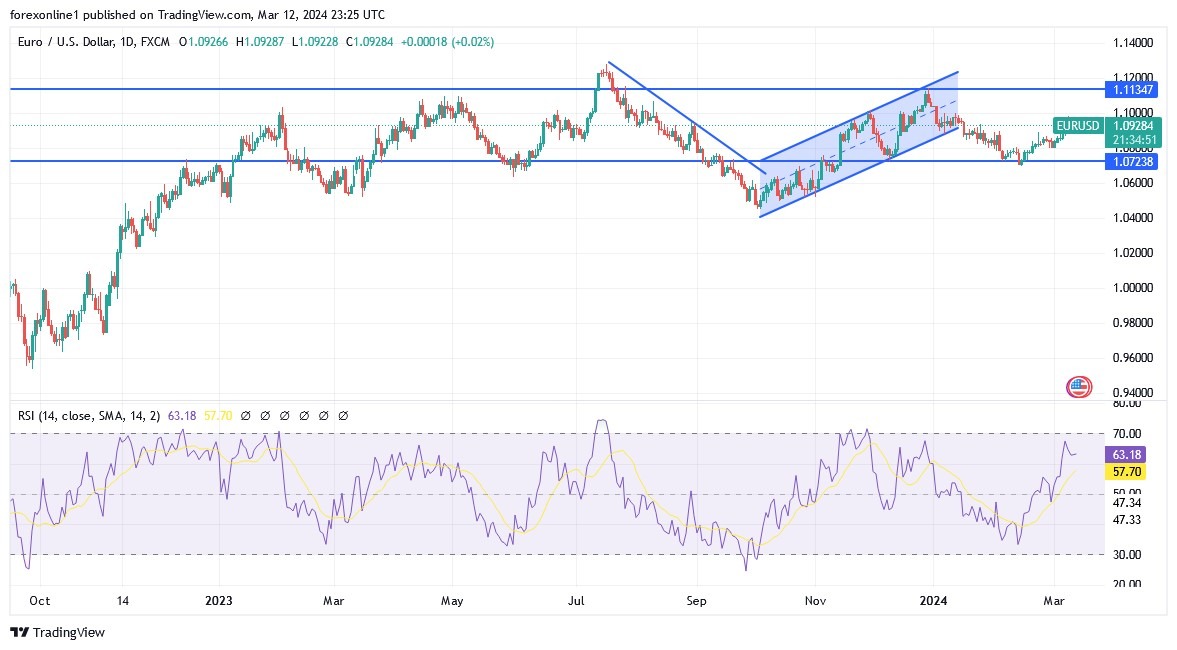- After a period of cautious stability, the price of the EUR/USD pair returned to the support level of 1.0902.
- Attempts to rebound higher for the EUR/USD pair had stopped at the resistance level of 1.0982 following the announcement of the US jobs numbers at the end of last week.
According to the Economic Calendar data, consumer prices rose in the United States of America last month, an indication that inflation remains an ongoing challenge for the Federal Reserve and the re-election campaign of US President Joe Biden, both of whom are counting on the continued easing of price pressures this year.
On Tuesday, the Labor Department reported that prices rose by 0.4% from January to February, higher than the previous month's figure of 0.3%. Compared to the previous year, consumer prices rose by 3.2% last month, exceeding the annual pace of 3.1% in January. Despite the elevated February figures, most economists expect US inflation to gradually decline this year. At the same time, the slight increase last month may confirm the cautious approach taken by the Federal Reserve towards US interest rate cuts.
The US government's budget deficit widened to $296 billion in January 2024 from a gap of $262 billion recorded in the same month of the previous year, nearly aligning with market estimates of $296 billion. Ultimately, this marks the sixth consecutive month of a US budget deficit attributed to increased defense spending and the replenishment of the Strategic Petroleum Reserve. During the first five months of the fiscal year, the deficit rose to $828 billion from $723 billion in the corresponding period of the previous year.
Government revenues in February saw a slight increase, while spending surged at a faster rate. Revenues increased by $9 billion on a yearly basis to reach $271 billion, while expenses increased by $43 billion to $567 billion. Moreover, the interest payments on federal debt during the first four months of the fiscal year increased by $127 billion compared to the same period of the previous year, primarily due to the rapid rise in US interest rates by the Federal Reserve.
Now, the question arises: Will the Euro's price decline in the coming days?
The recent recovery in the Euro's price against the US Dollar faces a key technical test after economic data revealed that inflation in the United States will remain elevated for some time. According to currency trading platforms, the Euro to US Dollar exchange rate (EUR/USD) once again fell to the 1.09 mark and to a significant support level after official data showed a rise in the core US Consumer Price Index by 3.2% on a yearly basis in February, up from the strong January reading of 3.1% and above the consensus forecast of 3.1%.
Top Forex Brokers
Overall, the likelihood of a US interest rate cut in June has diminished as the core inflation – excluding energy and food – remained unchanged at 0.4% on a monthly basis in February, surpassing expectations of a decrease to 0.3%. The "core" inflation rate “core services excluding housing” remained unchanged at 4.3% on a yearly basis for the second consecutive month.
EUR/USD Technical analysis and forecast:
According to the performance on the daily chart, there is neutrality to the performance of the price of the currency pair Euro against the US dollar EUR/USD. There will not be strong and continuous control of the bulls in the trend without breaking the psychological resistance 1.1000. On the other hand, support 1.0860 will remain the most important as the hopes of the recent rise evaporate.
After the recent US inflation numbers, we prefer selling the euro against the US dollar from every rising level. During Wednesday's trading, the EUR/USD pair is not awaiting important data from either the United States or the Eurozone, and therefore sentiment and reaction to the latest economic data will be factors guiding the EUR/USD's performance.
Ready to trade our Forex daily forecast? We’ve shortlisted the best currency trading platforms in the industry for you.


